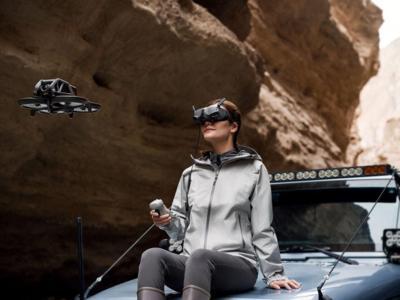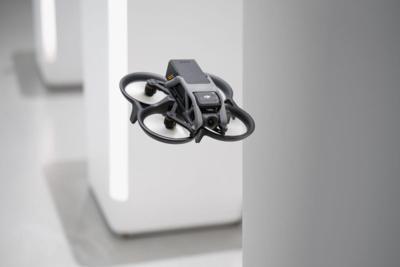New Drone Places Focus on VR-Like Controls and Immersive, Close Quarters FPV Flight
DJI has unveiled their newest drone, breaking the mold with a compact, sharp little unit geared towards agile, quick recording wherever necessary.

The Avata breaks from the usual convention among drones, opting to enclose all 4 electric rotors within an arrangement of rings directly underneath the fuselage. That small size makes it a perfect fit for cramped, high speed flights, where a larger drone with outboard motors might pose a hazard to nearby subjects or surroundings.
DJI placed a considerable focus on First Person View flight (FPV in drone parlance, though the acronym POV seems to be popular, if inaccurate slang), providing Avata pilots with super high res OLED goggles and a handheld motion controller. That design is meant to make the Avata feel like an extension of the body, aping the control setup common to virtual reality games to create a new level of immersion in the UAV market. Previous goggle systems were often a kind of kludge, small LED screens mounted onto frames that relayed the same picture from the drone’s main camera.
The Avata, however, fleshes out the goggle concept to DJI’s best yet. Two 1080p micro-OLED screens with a 100 Hz refresh rate allow for smooth, lifelike motion, with a range of locking diopter adjustment to accommodate a range of pilot shapes. The goggles are good for 2 hours of flight between chargings, with high speed recharging in between sessions bringing things right back online. The simple, single-hand controller allows intuitive motion control, with few buttons to get in the way. A natural hand angle and ergonomic trigger are a considerable departure from the usual 2-handed controls, so some longtime drone pilots may find them more polarizing than what they’re used to.

In the drone itself, DJI packs the usual complement of camera and flight performance. The Avata carries a nose mounted 4K camera, with a wide view 12mm lens. The sensor is a Type 1 with an F2.8, with 8MP 16:9 or 12 Mp 4:3 still photo capability. When recording the Avata can grab 4K60 UHD, 2.7K100, or 1080p100. Its compact frame is capable of hitting 31 mph in sport mode, or, in full-power manual mode 60 mph. That performance is a slight downgrade from its DJI predecessor, the FPV Pro’s 87 mph top speed, but the rest of the package improves on everything else. For anyone outside the drone racing scene, 60 mph will be suitable for many filming duties. The camera is joined by forward-facing obstacle and ground-facing ToF IR sensors to enable those high-speed, low altitude flights, which also improve stability while flying indoors or in close confines. The lack of side-facing obstacle sensors comes with the Avata territory, being designed for close-in, claustrophobic flying where necessary.
Between the missile-like high speed and side to side capability, operators should understand that flight requires some judgment and risk management. Battery life is said to be about 18 minutes for a full charge, so users may opt for a few extras to exchange.
Overall, the Avata Pro-View Combo retails for $1,388, which includes the aircraft, the DJI Goggles 2, and Motion Controller remote. A lower cost version knocks about $200 off that price and swaps the Goggles for the last model’s equipment, the DJI FPV Goggles V2. The aircraft alone can be had for aout $630, should a particular bird need to be replaced entirely. A banged-up Avata does have a few repair parts available, so easily swapped guards and frames can be patched up for a relatively paltry sum. Extra batteries run about $130 a piece.
 Aero-TV: DeltaHawks Diesel Power Steps Into the Spotlight
Aero-TV: DeltaHawks Diesel Power Steps Into the Spotlight NTSB Prelim: Mooney Aircraft Corp. M20K
NTSB Prelim: Mooney Aircraft Corp. M20K ANN FAQ: Turn On Post Notifications
ANN FAQ: Turn On Post Notifications ANN's Daily Aero-Linx (12.20.25)
ANN's Daily Aero-Linx (12.20.25) Aero-News: Quote of the Day (12.20.25)
Aero-News: Quote of the Day (12.20.25)




